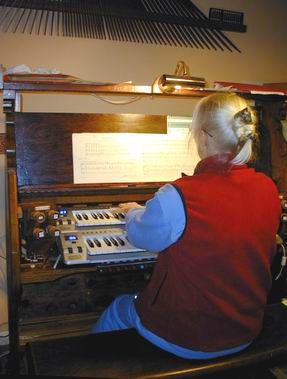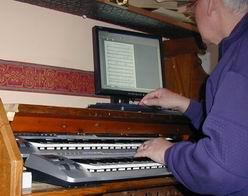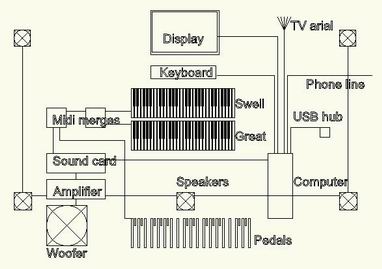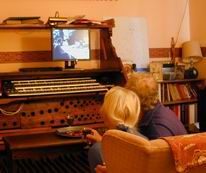Click on the "play" button to hear the same snippet from the Toccata by Dubois
played on our home digital electronic organ build in 2006.
The stop used was preset 119 with the Claribel Flute and Fifteenth played on the great and pedals.

When our church at Streatley bought the new Jennings organ, Plan "A" had been to somehow
ressurrect the lovely swell section of the old Binns organ at home. But when it was dismantled
all the pipes were used elsewhere. I was able to salvage the solid oak console and pedal board,
together with loads of tine timber from the skip! Plan "B" swung into action, I joined the
"Electronic Organ Constructers Society" and bought from member
Colin Pykett his excellent 136-page booklet on how to build one.
Along with the book came a small floppy disk with a "sound font" representation of a particular
pipe organ. Older electronic organs tried to re-create
the organ sounds. Newer digital organs are more modest in scope. Someone goes along with a sound
recorder to a real organ and records every pipe. After much "voicing" to make them balanced they
call all be encapsulated into the sound font. These are played by a particlar type of sound card,
in my case the "Creative Audigy" card which with its 64 indepedent "voices" is the heart of the
organ. Of course you need a computer (Dell Pentium 4) to drive the card and a nice sound system
(Creative Inspire 5.1 digital) to ease the sounds faithfully
into the air. I had to buy two electronic keyboards (Evolution MK361s) and two "Midi Merge" boxes
to connect them to the sound card. I bought from EOCS member Ron Coates and owner of
"Classic Organs",
the pedalboard MIDI interface. There was some real work connecting all the contact switches
from the pedal notes to the interface.

In 2007 Colin Pykett updated his design to allow any selection of
stops. There are four drawstops for both Swell and Pedal, and some 21
push buttons for the pedal stops, presets, couplers and other stops.
The drawstops use Hall effect switches: tiny transistor-like devices
whose voltage can be altered by the proximity of a tiny magnet embedded
in the shaft of the drawstop.

The console design the music stand folds down to reveal the monitor
screem amd become a large desk for normal computer activities.
There are telephone and broadband lines, and a TV tuner. A printer
and scanner are attached. The keyboard can still sound and the
large table is perfect for composing. Music can be played
from the keyboard directly into notation software.
A schematic diagram of the organ is shown below.

Now it all works! The sounds it makes are a real delight to my ears. Each pipe “speaks” just
like a real organ (the starting transient is measured and reproduced). The softly breathing
16' Bourdon, the stopped flute, and the open diapason are all there.
Click here to see and hear the individual pipe voices.
A difference of the present design
from a conventional organ is that that you do not add sounds from ranks, but select from 20
"pistons" selected sounds for the Great, Swell and Pedal manuals.

In the evening the organ can take on other lives. Here we are watching a DVD.
Copyright 2006 Colin Windsor : Last updated 23/7/2007
